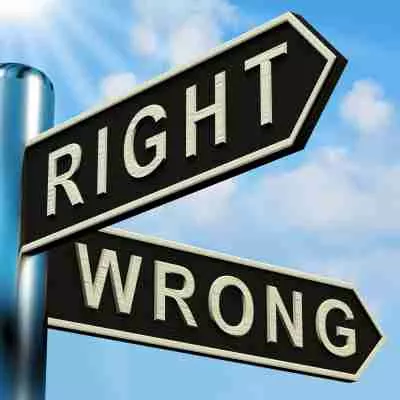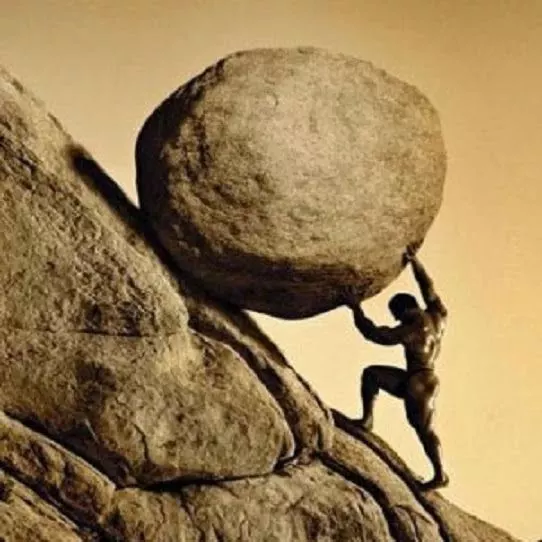“There is no holy life. There is no war between good and evil. There is no sin and no redemption. None of these things matter to the real you. But they matter hugely to the false you, the one who believes in the separate self. You have tried to take your separate self, with all its loneliness and anxiety and pride, to the door of enlightenment but it will never go through because it is a ghost” ~ Deepak Chopra
One of the final frontiers to conquer in the path to a spiritual awakening or enlightenment is the belief in the concept of right and wrong. This belief has such a stronghold on most of us, that to even fathom that there exists such a state of consciousness (one that transcends the illusion of right and wrong), is almost impossible for most to wrap their minds around. Therein lies the problem.
Anytime the mind is involved in processing a situation, it must put its two cents in. It must name each situation as either “good” or “bad”, “right” or “wrong”. These judgments are projections of our ego. The ego NEEDS to be right, so in order to be right, there MUST be a wrong.
Therefore the ego spends the day making comparisons. It compares political parties, it compares religions, it compares parenting styles, it compares cultures, everything…

The problem is that your ego, just like mine, just like everyone else’s on the planet is operating from the perspective that it is the “right” one… but with over 7 billion people living on the planet how are we to know who officially has the golden key to the “right” way to do everything?
Is there really a being that exists that knows the “right” way? The “right” way to cook a steak, the “right” God to worship, the “right” nationality, the “right” culture, the “right” reason that killing people is justified?
“People are doing the best they can from their own level of consciousness” ~ Deepak Chopra
In order for there to be an official right way to do things and wrong way to do things, is to assume that there is someone or something that is judging every single one of our thoughts, actions and behaviors against this supposed “rule book” of what is considered right and what is considered wrong. T
his is where those who believe in organized religion can chime in and say, “Well yes, that person is God. That book is The Bible, or The Koran, or the (insert religious text here).” But sadly, enough even those who believe in organized religion, can’t even agree with each other.
There are Christians who believe in picketing in front of people funerals, or the ones that believe invading other countries and killing their citizens is ok (as long as they’re doing it in the name of Jesus, of course).
And it’s not only Christianity, but all the religions who have dissent among the ranks, so even then, how are we to know which way is the right way to follow God and which is the wrong way? We can’t. We can’t know because there isn’t only one way.
Yes, human beings have spent thousands upon thousands of years fighting for what’s “right”, when in all actuality, every single person on this earth is operating from their own level of consciousness. Which means, everyone is operating from the frame of mind that they are doing the “right” thing.
We have spent so much time pointing the finger at everyone else under the guise that we were right and they were wrong, but all the finger pointing and judging and comparing has never really solved anything.
If everyone, including ourselves, is operating the best they can from the level of consciousness they are existing at, can anyone really be blamed for anything? Technically no.
For example, we’ve all heard the phrase “hurt people, hurt people.” This sums it up, people who don’t have unconditional love for themselves go around treating others the same way they feel towards themselves. They are literally acting in the only way they know how to from the level of consciousness that they exist at.
 So yes, there will be times when people exist at a level of consciousness that tells them that anger, or fighting or even worse, killing is what they need to do and in these instances if people become a danger to themselves or society they will have to go to jail or be punished in court etc.. but it is not our duty to come up with a million “what if” situations, we must deal with life as it happens in the present moment, as it is presented unto us and we must trust that perfect action will always be taken.
So yes, there will be times when people exist at a level of consciousness that tells them that anger, or fighting or even worse, killing is what they need to do and in these instances if people become a danger to themselves or society they will have to go to jail or be punished in court etc.. but it is not our duty to come up with a million “what if” situations, we must deal with life as it happens in the present moment, as it is presented unto us and we must trust that perfect action will always be taken.
This may be hard for a person’s ego to process. The ego needs to blame, it needs to blame OTHER people, because if it doesn’t have other people to blame for all of its problems, fears and upsets, then that means it has to look back at… GASP… itself as the problem. The ego’s perception of reality is what is shaping our judgments about the external world.
However, the thing that is coming up with the judgments IS the ego, so basically what is happening is the ego is calling that group of people ‘wrong’, and then blaming THEM for the judgment it came up with on its own accord. Seems silly, right?
“Hurt people hurt people. That’s how pain patterns get passed on, generation after generation after generation. Break the chain today. Meet anger with sympathy, contempt with compassion, cruelty with kindness, greet grimaces with smiles, forgive and forget about finding fault. Love is the weapon of the future.” ~ Yehuda Berg
Transcending the judgments of good/bad, right/wrong is not an easy task. Although those who can feel the rise in their level of consciousness will tell you they can feel their ego’s grip on reality slipping away slowly, it’s rare to meet someone who is existing in this level of consciousness 100% of the time.
What is important to realize is that we cannot force a higher level of consciousness on ourselves, we can only bring more presence into our lives and find the connection to our spirit which will cause our consciousness to rise naturally.
Intellectually we may know that there is no right or wrong, but if our ego is still at the point where it is in fact using these judgments on external reality, we must only be aware of it, not judge ourselves because of it.
The new evolution of our consciousness will eventually transcend the duality of the mind, so until we exist solely at this unity consciousness where we see all as one, all we can do is show unconditional love to ourselves, which will eventually spill over to other people.
Loving people unconditionally is the only way to change them, and loving ourselves unconditionally is the only way to change ourselves.
Like Yehuda Berg said in the quote above… “Love is the weapon of the future.”
Image Source








 So there you are, King Nothing, trying to figure out what went wrong. Sure, you still have money, but so what. Nobody looks at you the same anymore. It must have been something you did.
So there you are, King Nothing, trying to figure out what went wrong. Sure, you still have money, but so what. Nobody looks at you the same anymore. It must have been something you did.









 We create problems for ourselves when we sit in resistance of a situation, we believe in our heads that things should go a certain way and when they don’t go that way we are frustrated.
We create problems for ourselves when we sit in resistance of a situation, we believe in our heads that things should go a certain way and when they don’t go that way we are frustrated.


